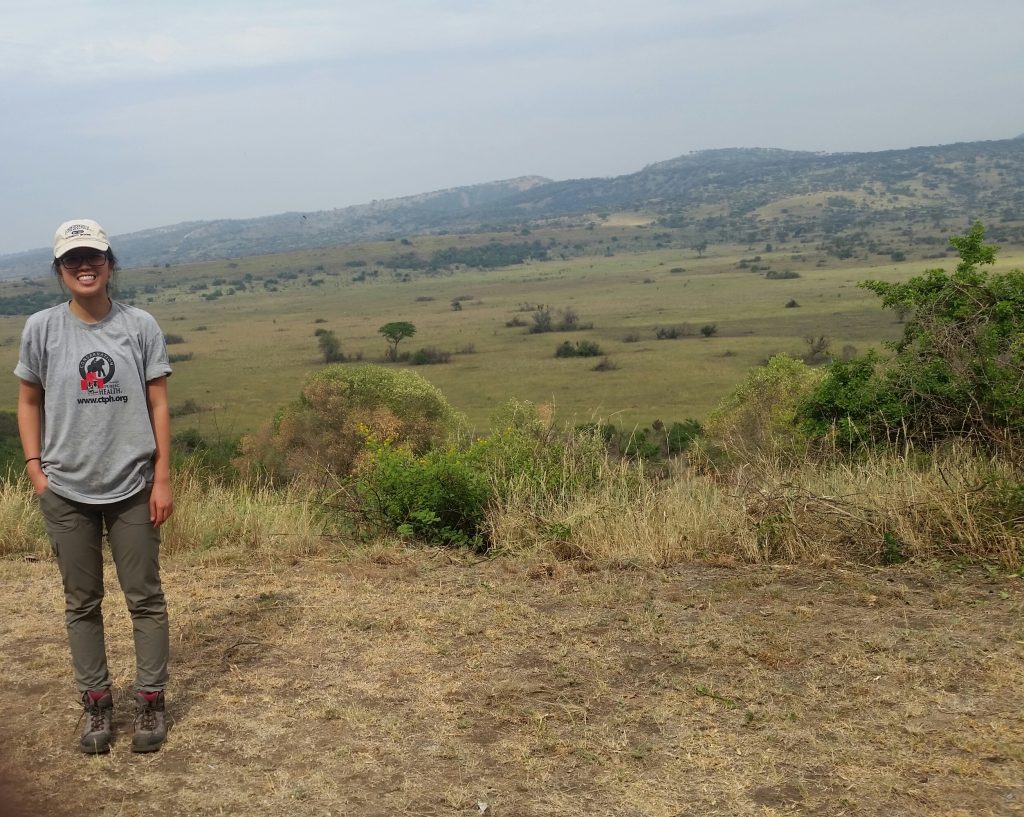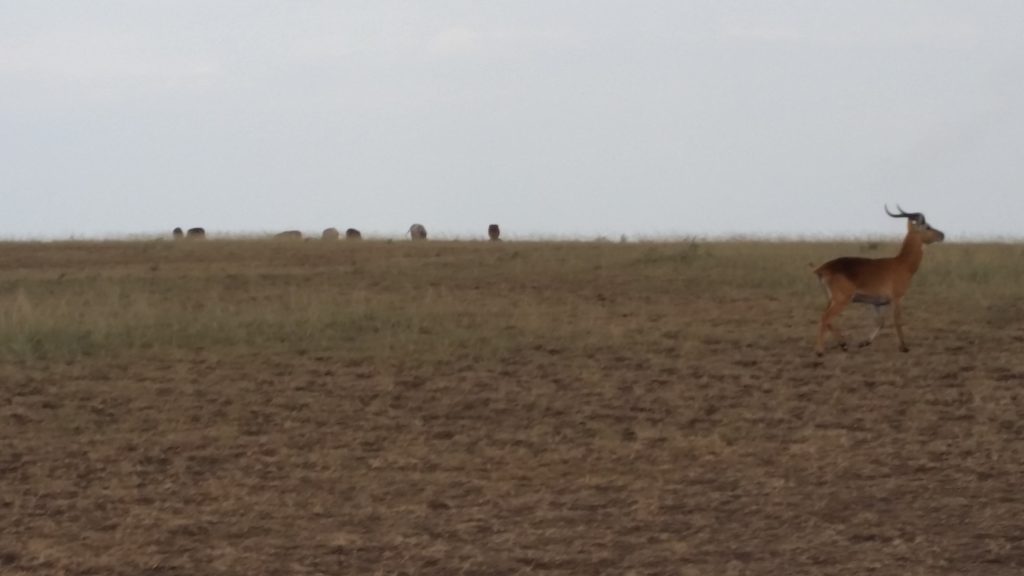Thanks to funding from Expanding Horizons, this summer I partnered with Conservation Through Public Health (CTPH) to conduct research in Queen Elizabeth National Park (QENP). CTPH is a non-profit non-governmental organization, focused on improving the health of animals and people around protected areas in Africa while also advancing initiatives in wildlife conservation. Put more simply, it addresses the reality that wildlife conservation cannot occur without simultaneous partnership with humans whose livelihoods are closely intertwined with, and often dependent on, the same resources that endangered wild animals need. In my opinion, one of the most interesting problems in wildlife conservation is how to make conservation a priority for everyone. Dr. Gladys Kalema Zikusoka, one of the founders of CTPH and the first wildlife veterinarian for the Uganda Wildlife Authority (UWA), was motivated to address this need. Since it was founded in 2002, CTPH has implemented public health programs in Bwindi Impenetrable National Park, QENP, Mount Elgon, and other protected areas in Uganda. CTPH has worked in communities with significant interaction with wildlife, training Conservation Community Animal Health Workers to assist researchers in sampling animals and to report signs of disease outbreaks to UWA.
My objective for this summer was to conduct research on the prevalence of brucellosis and tuberculosis, both zoonotic diseases with the potential to infect humans, in African buffalo and cattle in communities around QENP. Three different villages around QENP were chosen based on disease prevalence of free range cattle and proximity to the national park. In a study published by Dr. Gladys and other researchers in 2005, the prevalence of Mycoplasma bovis and Brucella abortus was 22% and 2%, respectively. The first survey of bovine tuberculosis in QENP in 1960, which was referenced in Dr. Gladys’ study, concluded that the disease had originated in cattle and spread to buffalo. Infected buffalo were only found in areas of the park close to villages with cattle that were positive for tuberculosis. Since this wildlife reservoir has been established, the challenge now is to eradicate the disease in both populations. My research consisted of conducting surveys of pastoralists, and sampling blood from cattle to perform laboratory tests for the infectious diseases. Having worked in research laboratories throughout my undergraduate career, it was easy for me to learn the procedure for the brucellosis serum agglutination test. However, it was much more fulfilling to conduct surveys because I learned so much about common practices in raising cattle outside the United States, perceptions of foreign researchers, and how it is extremely challenging to control all the variables when conducting research in the field.
To conduct surveys, I woke up at 5:30 am to drive to villages before the cattle were led, by herdsmen, into QENP to graze for the day. It was necessary for the cattle to leave so early in order to begin feeding before the heat of the day reached its peak. Our team once drove over five miles into QENP to chase after a specific group of cattle to sample. That journey was a testament to how much energy the cattle had to expend to find food, relative to the poor nutrition they received from the dry, brittle, and overgrazed grass.
In a moment that made the fatigue from chasing cattle worthwhile, I spotted a buffalo and a few Ugandan Kob mingling with the cattle. Just as there are no boundaries between wildlife and livestock, there are no boundaries between livestock and humans in the village. If a buffalo infected with Brucella abortus were to have an abortion in QENP, and a grazing cow ingested the placenta or vaginal discharges, the infection could be passed to the domestic cattle. A human that drank raw milk from an infected cattle could then become infected, as well. The challenge of developing boundaries of QENP around and within pre-existing communities without allocating grazing land is there there are insufficient natural resources. Cattle cannot rely solely on grazing within the village. While the government punishes people for grazing cattle in QENP, it does not provide alternative methods to feed cattle that are affordable. Nutrition is essential because cattle or buffalo that do not receive enough nutrition from grazing have a less robust immune system to respond to and eliminate infection.
Before beginning my research, I traveled to each village and met each village leader. The village leader is an elected individual who holds the most political influence within the village. Dr. Kellen, a Ugandan wildlife veterinarian, translated information about CTPH, the research project, and what we would need. After receiving support from all three village leaders, we traveled from house to house with a local to facilitate introductions.
Despite the support of the village leaders, I immediately ran into opposition from community members. At the first house, before we had finished communicating the premise of our research, a villager interjected to say that many researchers in the past had come, collected samples from his cattle and asked him questions, but none had distributed any results or provided compensation. This theme was repeated throughout houses in all three villages. There were also accounts of researchers injecting vaccines around the tail-head of cattle and causing necrosis of the entire tail. Anyone who assumed that we were researchers from Ugandan Wildlife Authority refused to talk to us or allow us to sample their cattle. It was concerning to see that the governmental body responsible for protecting wildlife did not seem to have the support of the people. UWA charges entrance fees for almost all the protected areas in Uganda, for many safari and animal tracking opportunities, and for permits to conduct research on animals in Uganda. However, only a small percentage of this income is given to the communities around the national parks, provided that the people have demonstrated certain initiatives toward advancing wildlife conservation.
Once we explained that we were with Conservation Through Public Health, an independently-run, Ugandan-based organization with a history of disseminating results back to communities, the locals became much more receptive to participating in our research. I surveyed 51 pastoralists and sampled 97 cattle. Through the surveys, I was able to analyze the risk factors, such as handling of newborn calves, slaughtering of cattle, and type of milk consumed, that could lead people to brucellosis infection. I learned that the local name for brucellosis was omusuja gwente, which translates to malaria of cows. Wildlife conservation will only succeed with teamwork from multiple different sectors, and without the pastoralists reporting infectious disease outbreaks to veterinarians and UWA, a significant player in disease detection would be lost.
As a result of the surveys, I identified certain practices that places people at risk for brucellosis transmitted from cattle, including close contact with newborn calves, and leaving aborted calves in the fields or feeding them to other animals. Thirty-nine percent of respondents had observed at least 3 clinical signs of brucellosis in their cattle (abortion, stillbirth, weak calf, retained placenta, orchitis/epididymitis). From the serum agglutination test for brucellosis, I determined that there was 0% prevalence of B. abortus in the cattle that were sampled. While this is positive preliminary data, more in depth investigation should and will be conducted to whether this is the true prevalence.
As a pre-veterinary student, a professor encouraged me to pursue both wildlife and livestock interests because of the need for veterinarians in developing nations. It was a concept that was very new to me then, but resonates with me now. My initial plans for darting and sampling buffalo for my project were canceled due to numerous bureaucratic issues, but I learned that wildlife veterinary medicine isn’t usually chasing outbreaks or performing surgeries. I have a lot more to learn and explore, but I am very glad to have journeyed to Uganda to get a glimpse of what is possible in the years to come.
ABOUT THE AUTHOR:
Amy Trey is a third year veterinary student from Bayside, NY, interested in infectious diseases and the wildlife-livestock disease interface. She graduated from Duke University in 2015 with a Bachelor of Science in Chemistry. Currently, she is a member of the Cornell chapter of AABP, a volunteer at the Cornell Wildlife Health Center, and an emergency surgery technician at the Large Animal hospital.



